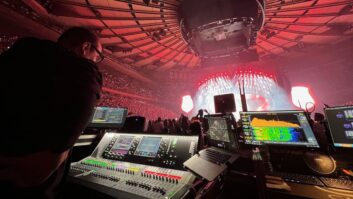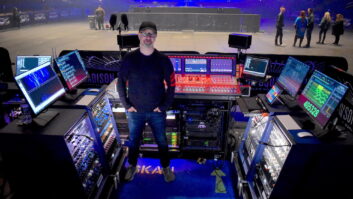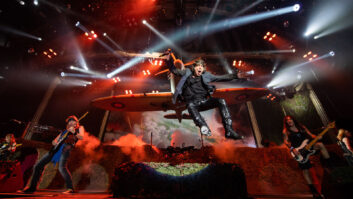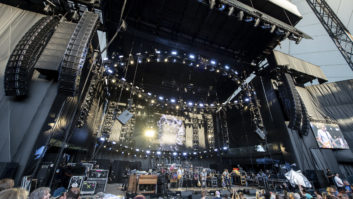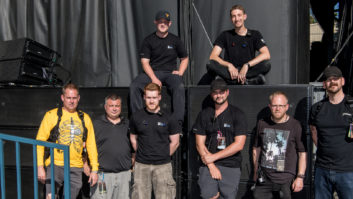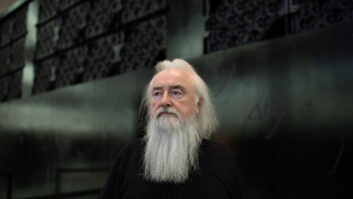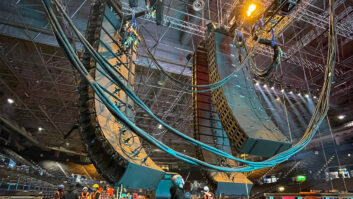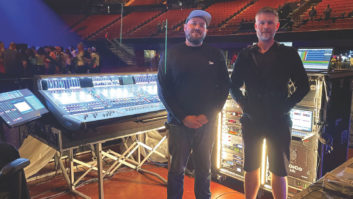The Who audio crew (l to r): Carl Popek, Drew Marbar, Robert Collins, Simon Higgs and Mark Brnich.
New York, NY (February 26, 2013)—The Who close out their current U.S. tour marking the 40th anniversary of the rock opera Quadrophenia with a charity gig on Thursday night in New York City.

The Who’s Quadrophenia tour started in November, marking the band’s first major North American tour in four years. Even long-departed drummer Keith Moon and bassist John Entwistle make cameo appearances nightly, joining remaining original members Pete Townshend and Roger Daltrey. Entwistle’s virtuosity and famous bass solo on “5:15” are showcased in live footage shot at the Royal Albert Hall in 2000, which streams onscreen. The band also pays tribute to the late Keith Moon, as the performance of “Bell Boy” incorporates video footage of a 1974 performance, with Moon’s vocals dubbed in from the LP (one of the only times in Who history his vocals were heard on an album).
The Quadrophenia tour also reunites the band with production partner Eighth Day Sound, which has worked with the act on its last three major tours. This time out they’re carrying a pair of DiGiCo SD7 desks (each running the latest Mach III software) for FOH and band monitors, plus an SD-Rack at FOH and a d&b audiotechnik J-Series PA. The audio crew is comprised of longtime Who FOH engineer Robert Collins, Simon Higgs on monitors with support from Eighth Day’s Senior Audio Engineer Mark Brnich, and sound techs Drew Marbar and Carl Popek.
Collins started with the band in the late 1990s-early 2000s, and has also worked with Roger Daltrey and Pete Townshend on solo projects, trading tours with engineer Paul Ramsey in between tours with Eric Clapton and others. “Paul used to look after me; he was my systems tech on The Who. I made sure the team was put in place, you know, ’cause an English band should have an English engineer—or British, I should say. I’m Welsh, though. So here I am back. They wanted to get me back for this, and luckily it worked out timing-wise with the schedule. It’s worked out with Eric, so I can go do that as well this year.”
A relative newcomer to the SD7, Collins is no stranger to DiGiCo, having been an early D5 adopter. The engineer says he wouldn’t part with his trusty D5 until this tour. “I wasn’t ready to go to the SD7 until I knew we had the new racks… and honestly I couldn’t justify going to an SD7 working with a four-piece (like Clapton) playing blues and such, you know? I mean, that thing can run a small country, can’t it?! But for this tour, it seemed like it was time.”
Monitor engineer Simon Higgs presides over the other SD7 at stage left, managing approximately 112 inputs for IEMs and such for the nine-piece band. He’s also a veteran Who member, starting in ’98 with Townshend on his Lifehouse project. “It’s the only digital console that I really care to use and the only one I really like,” Higgs explains. “I used a D5 with the Los Angeles band Sparks when they did 21 albums in 21 shows back in 2007, and that was the first time I really used the D5 for an extended tour… 150-odd songs, all programmed in. The Who’s monitor mix was analog for a long time until it started getting bigger and bigger and we realized we had to move to digital. So we started using two D5s, but that filled up quick. We currently are using an analog console for Pete, who has his own operator, and I look after the rest of the band on the SD7.”
With nearly 112 channels, Higgs says he has a lot going on managing the band’s in-ears, a few random wedges around the stage and submixing stems for Townshend’s mix. “My desk is pretty full; 112 channels and they’re pretty much filled up. A lot of outputs. I’ve still got some floor monitors up there. I’m mixing down to the analog console as well, which is just a 16-channel desk, so I’ll mix all the drums, drum floor monitors, drum sub, floor shakers [drum thumpers] under his seat…”
Having everyone on in-ears has made his job a bit easier. “Roger decided that in order for The Who to work again, he had to get used to in-ears… he couldn’t have a half-dozen wedges all around him like he used to. So he’s gone through the whole process of getting used to in-ears,” Higgs explained. For effects, he’s primarily using what’s in the console, save a few outboard pieces, including a Lexicon PCM 60 for the snare drum, and a Bricasti M7 reverb for Roger’s vocal that he says “is absolutely amazing.”
DiGiCo
www.digico.org
